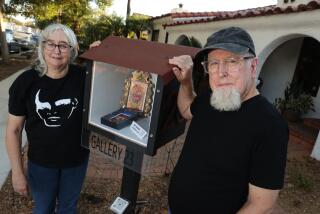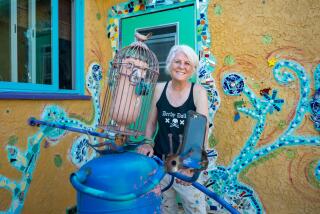Coming to Grips With Art for the Public’s Sake : Port members should be looking for works that expand our understand- ing of our relationship globally, works that acquaint people with Pacifc Rim and Latin American artists.
- Share via
The San Diego Unified Port District is trying to resurrect its troubled, $2.2 million public art program, which began in 1982 but which to date has seen only one work installed. It has hired two consultants to conduct public hearings and develop a master plan. The last of four hearings is at 6:30 p.m. Wednesday at the Holiday Inn Embarcadero, 1355 N. Harbor Drive.
The Times asked three arts professionals, artists Robert Irwin and David Avalos and art historian Sally Yard, for their thoughts on public arts programs.
It is inadequate to call for public hearings and then get input and move on. The public voice at point A would be trying to influence decisions six months or six years later.
Unfortunately, the public is usually brought in to veto what has been decided.
Community input should be ongoing. And attempts should be made to make it as intimate as possible.
Perhaps several artists could be brought in to meet with a community group. These talks might be facilitated by consultants, but the process should not be filtered through arts administrators. The artists and the community need to talk directly to each other and come up with a place for public art and an idea. The community group would have as much say in the project as the Port commissioners.
Some artists would not be comfortable with that process, and other artists would jump at the chance.
This is not to advocate an approach in which we vote on public art, and the majority rules.
If we really want art that can embrace individual expression, then we need to call on society to be tolerant of minority opinions.
Does one criterion of public art have to be that it offends no one? That’s antithetical to a society with democratic principles. And, judging by bumper stickers saying such things as, “No Fat Chicks,” and the discomfort among some people in North County over seeing Mexican laborers, the vast majority of people in San Diego would be kept off the streets under that criterion. But neither does it have to be confrontational; public art should include a diversity of voices and approaches.
Public art is about turning a public space into a place that is a home for all of us.
The Port’s public art program should be addressing San Diego’s relationship to the Pacific Rim and the border. The Port commissioners should be looking for works that expand on our understanding of our relationship globally, works that acquaint people with artists of those parts of the world. It should be an international forum.
Also, money needs to be made available for a community-input process that starts from the moment a site is selected and continues indefinitely. That would allow people to have ongoing communication with the artists and would help educate school groups or develop projects that involve schoolchildren.
The master plan should also include a program of interface between the Port and the university and arts communities. Perhaps an artist-in-residence program for three to six months, rather than a permanent piece.
Let’s hope that the master plan is more than just an atonement for past sins. The plan should be innovative and help establish connections between the Port and the international community, between the Port and the social and educational institutions in San Diego.
It should encourage an ongoing sense that the art works are not just the Port Commission’s, but that they belong to all of the people in the cities represented by Port and they can become a part of everyday life.
More to Read
The biggest entertainment stories
Get our big stories about Hollywood, film, television, music, arts, culture and more right in your inbox as soon as they publish.
You may occasionally receive promotional content from the Los Angeles Times.










